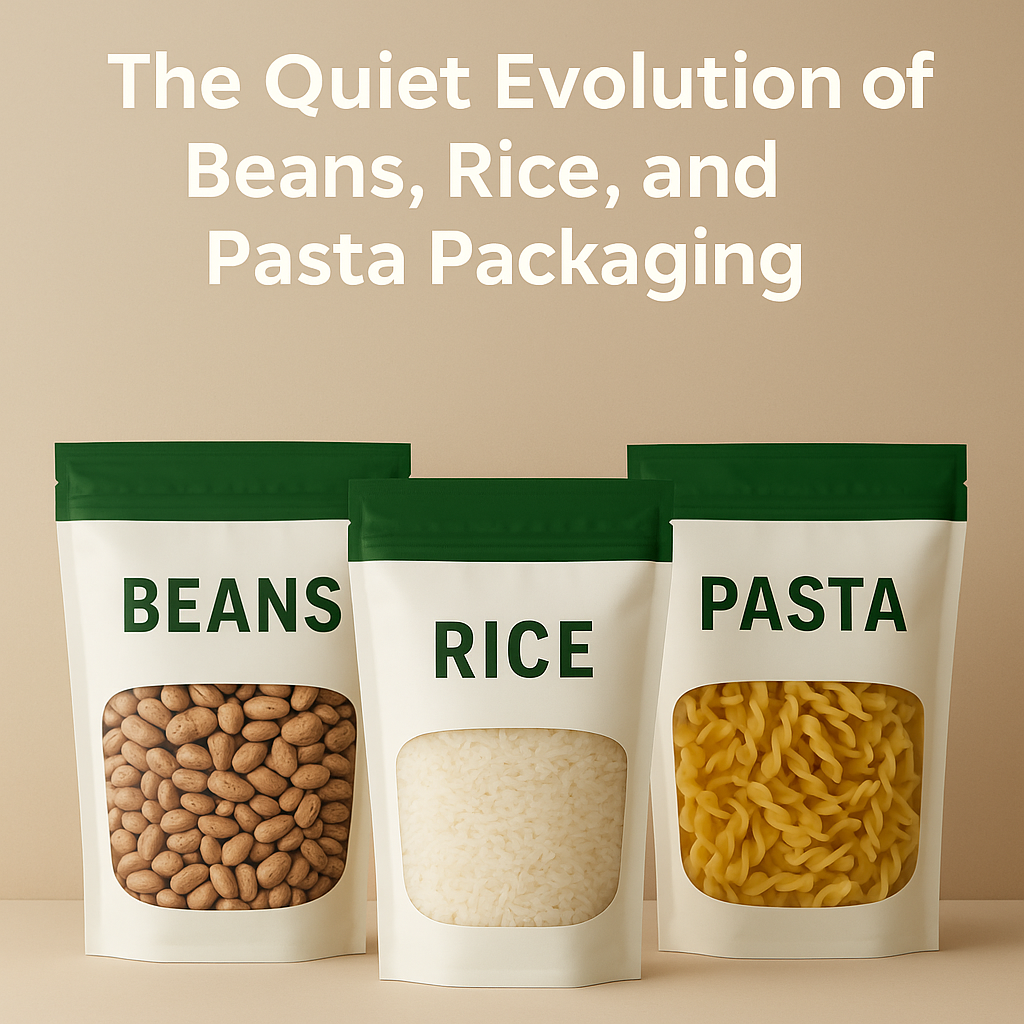The Quiet Evolution of Beans, Rice, and Pasta Packaging

Packaging for beans, rice, and pasta seems straightforward, but it requires precision. These products vary in density, particle size, and moisture behavior, which means the materials used in bean rice and pasta packaging must do more than simply contain the product. They need to maintain a dependable barrier against oxygen and humidity, hold shape under load, and seal consistently in dusty, high-speed environments.
Traditional mono-layer polyethylene and basic laminates often fall short of these requirements. Over time, they allow gradual vapor ingress, develop weak seals, and lose structural integrity during transport. The result can be shortened shelf life, product waste, and quality inconsistencies.
While advances in flexible materials have improved performance, challenges remain. Variability in product flow, sealing conditions, and film compatibility still affects outcomes. The following section examines the most common packaging problems that continue to influence dry-staple packaging performance.
Packaging Challenges in Dry Staples
1. Moisture and Oxygen Control
Dry goods are hygroscopic, meaning they absorb or release moisture depending on ambient humidity. Even minor vapor transmission can affect product texture and cooking quality. Traditional films with high Water Vapor Transmission Rate (WVTR) and Oxygen Transmission Rate (OTR) fail to maintain consistency through long distribution cycles. The result is clumping, hardening, or loss of freshness before the intended shelf–life ends.
2. Seal Integrity Under Contamination
Fine dust from rice or beans often enters the sealing zone during filling. Uneven temperature or pressure creates incomplete fusion at the seal interface. These micro-defects, though invisible, lead to leaks or separation under compression. Reliable pasta, beans, and rice packaging requires sealant layers that can tolerate small particulate contamination without compromising closure strength.
3. Mechanical Strength and Puncture Resistance
Product geometry directly impacts packaging performance. Pasta edges and bean corners create stress points inside the bag. Films lacking tensile strength or elongation can tear or puncture under load. During storage and transport, low-stiffness materials compress unevenly, causing abrasion or deformation. The ideal film balances flexibility and stiffness to preserve package integrity.
4. Stackability and Dimensional Stability
Bag shape affects pallet efficiency and shelf appearance. A film with defined stiffness and slip properties helps maintain shape throughout distribution, essential for rice, beans, and pasta packaging, where stack stability matters.
5. Sustainability Requirements
Sustainability now drives material selection. Older multi-material laminates offer strength but aren’t recyclable, while thinner mono films save weight but sacrifice barrier protection. The target is a structure that achieves barrier performance, machinability, and recyclability, a key focus in next-generation dry-food packaging.
From Film Design to Line Efficiency: The Engineering Behind Reliable Packaging
1. Engineering Balance: The Foundation of Modern Packaging
In beans, rice, and pasta packaging, performance depends on a balance between protection, seal integrity, and mechanical stability. A laminate must keep oxygen and moisture out, seal reliably under variable line conditions, and hold its shape from pallet to shelf. Each layer, barrier, sealant, and structural component contributes to that outcome.
Barrier coatings such as EVOH, PVDC, and Alox maintain product freshness through extended distribution cycles. Polypropylene-based outer films provide stiffness and puncture resistance, ensuring the pack stands upright and resists stress. Meanwhile, inner sealant layers maintain closure strength despite dust or small temperature variations during sealing. When engineered as a unified structure, these materials work together to preserve both quality and line efficiency, something single-layer films cannot achieve.
2. Proven Performance: Validation Through Process Control
Designing a film is one part of the equation; ensuring it performs consistently under production conditions is another. Reliable packaging depends on verification, not assumption. Every laminate must be tested and qualified to run within a defined performance window.
That validation involves measuring oxygen and vapor transmission rates, seal strength across temperature ranges, and tensile durability under load. These data points establish the operating limits, including dwell time, temperature, and web tension, that maintain uniform and stable packaging at high speed. When production stays within that window, the result is steady output and minimal waste.
Consistent sourcing and regional manufacturing strengthen that reliability further. With materials produced and tested close to where they’re used, variability between batches is minimized, and operators can trust that performance remains identical from run to run.
3. Real-World Integration: Where Materials Meet Machinery
On the packaging floor, even the most advanced laminate depends on the precision of the machine that runs it. Web tension, sealing heat, and dwell time must stay within tight tolerances for the film to perform as designed. Small drifts in alignment or friction can alter how smoothly the material forms or seals.
This is where Unified Flex’s system-level approach comes in. Each packaging line is calibrated around its chosen film structure, sealing temperature, dwell profile, tension control, and feeding dynamics are tuned together. When material properties and equipment behavior are synchronized, lines reach full efficiency with fewer adjustments and less waste.
That precision translates directly to performance. Packages maintain shape, seals remain secure, and throughput stays consistent, shift after shift, batch after batch. The packaging process becomes predictable, measurable, and built for long-term reliability.
Conclusion
Effective packaging for beans, rice, and pasta isn’t defined by complexity; it’s defined by control. When film design, process validation, and equipment calibration work together, the result is measurable: longer shelf life, fewer stoppages, and packaging that performs predictably from the first run to the last.
Traditional single-layer films can no longer meet those standards. Today’s operations demand multi-layer laminations that balance strength, sealability, and sustainability, materials that can run efficiently, reduce waste, and maintain quality through long production cycles. Through controlled engineering, testing, and integration, flexible packaging now delivers that performance with consistency that can be measured and proven.
At Unified Flex, every solution is developed around this principle of process control. From film specification to equipment setup and performance validation, each stage is designed to protect product integrity and maintain production efficiency. Because in dry-goods packaging, progress isn’t about adding complexity, it’s about engineering reliability into every layer of the process.